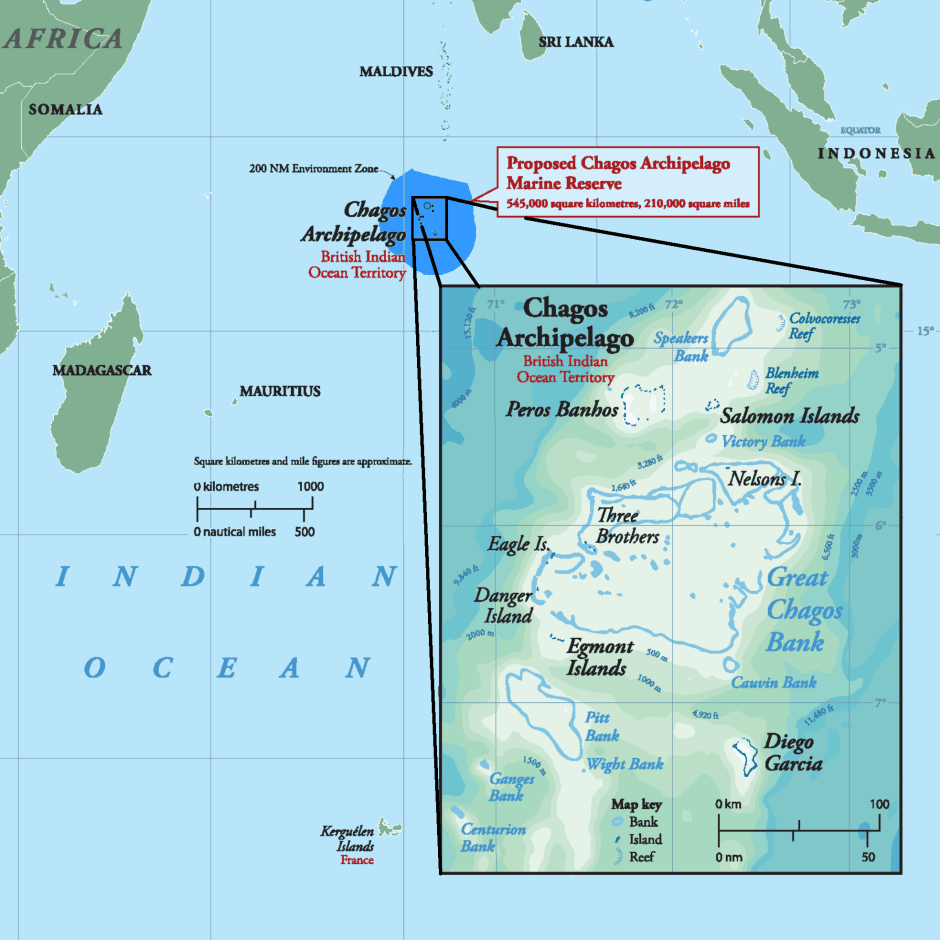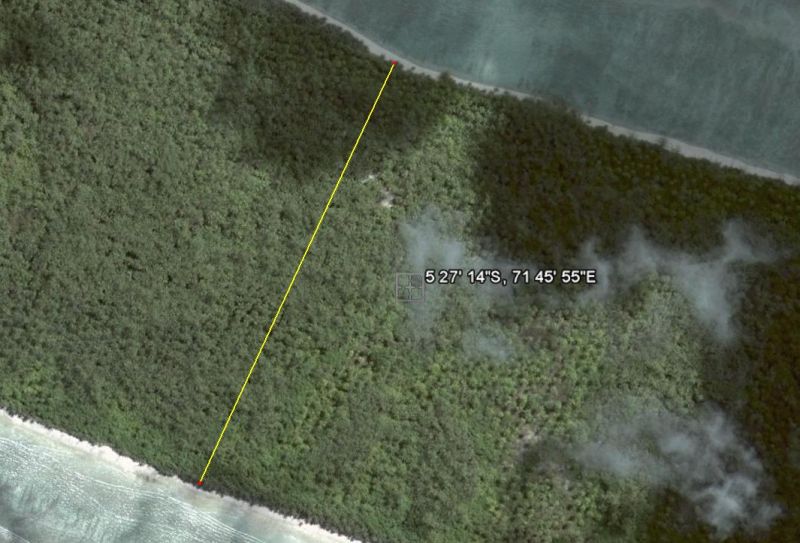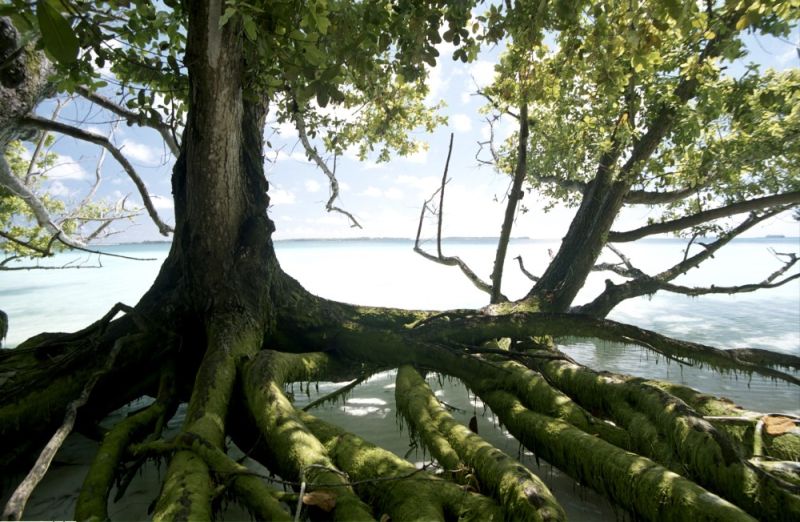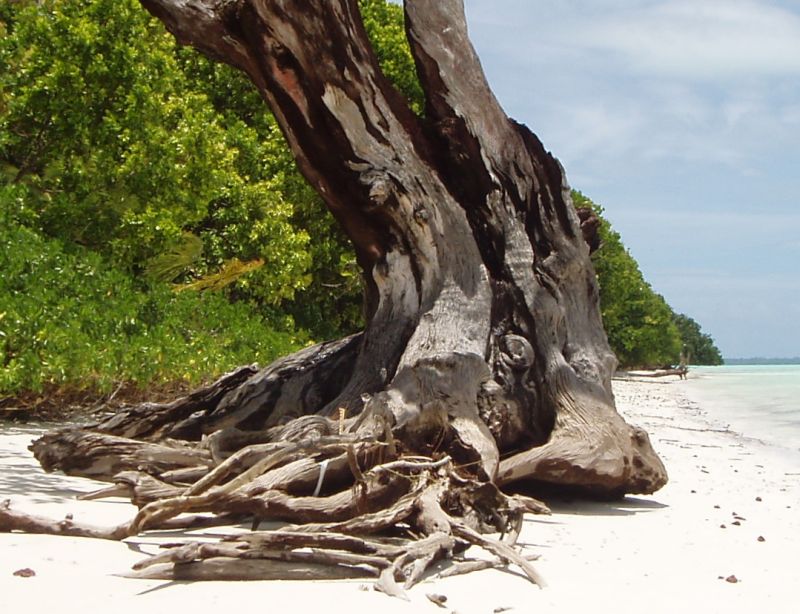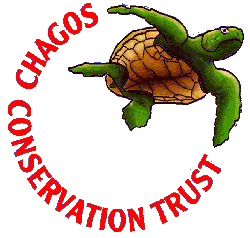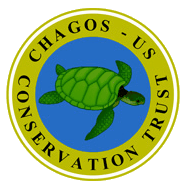Visit the Rest of The PPDRDG by Returning to the Site Map and Picking Another Page!
The Provisional Peoples' Democratic Republic of Diego Garcia, a.k.a. PROPEOPDEMREPDG; a.k.a. PPDRDG (The Web Site Providing the World With Its Diego Garcia Fix Since August 20, 1998) The PPDRDG Thanks Everyone who Helped SAVE THE CHAGOS ARCHIPELAGO! |
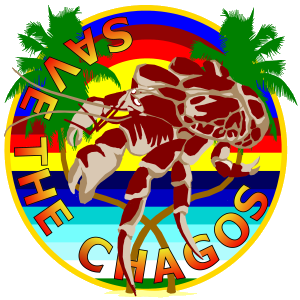 |
|
|
Those of
you who have read this website over the years know
of my love for the natural beauty and environment of
Diego Garcia and the rest of the Chagos Archipelago.
You may not know it, but Diego Garcia is the largest
continuous atoll in the world, and the Chagos
Archipelago is the 2nd largest living reef anywhere
(after the Great Barrier Reef). Ecologically,
it is critical to the health of the Indian Ocean,
and a key bell-weather for detecting marine
environmental problems and in determining if climate
change is actually happening and if it is, to what
extent. Those of us who spent time out there
remember the unpolluted waters, the unspoiled reefs,
the clean air, and the abundant birds, wildlife and
sea life. These are the classic signs of a
healthy environment! Because
of its remoteness, lack of any population trying to
make a living off the natural resources of the
archipelago, the wise environmental regulation by
the Brits and the DoD, and the care taken by the
American and British Sailors, Marines, Airmen,
contractors and Merchant Marines over the last 40
years, the Chagos Archipelago is the most pristine
marine environment in the Indian Ocean, if not the
world. On
November 10, 2009 the British Foreign Secretary,
David Miliband, announced that the UK Government was
seeking comments on a proposal to preserve the
Chagos that way forever and for all mankind by
creating the world’s largest Marine Protected Area
(MPA). He went
on to say, "I strongly encourage you to participate
in this consultation." By that he meant the
whole world could comment, and that included
veterans of Diego Garcia! After all, there are
over 100,000 of us, and we sacrificed a big portion
of our lives out there defending the free world, and
it's was only right that many of us spent a few
moments to help protect the place that meant so much
to us once upon a time! In the end, over 275,000 people world-wide sent in comments and signed petitions, with 90% favoring the creation of the MPA (I mean, what in the world were the other 10% thinking?), and on April 1, 2010, the Foreign Minister announced that the UK would establish the MPA. Here's the news release: http://www.fco.gov.uk/en/news/latest-news/?view=News&id=22001512. And here is the full 30-page report: http://www.fco.gov.uk/resources/en/pdf/3052790/2010/marine-life-apr-2010.
|
||
|
Like most of my readers,
I spent a lifetime on Diego Garcia one year, and
therefore feel uniquely qualified to make random
pronunciations about DG and all things around or
about it. Plus I've been running a website
about the darn place for more than a decade, so I'm
doubly qualified. So, here's what I think
about:
 FAQs
About
the Chagos Protected
Area
Here is a set of Q&As compiled by
scientists and other people intimately involved
with the MPA and the science of the
Chagos: http://www.chagos-trust.org/news.asp?id=17.
The
Coral
Cay Conservation website keeps up on the
latest Q&A issues as well. You can
also listen
to
Professor Charles Sheppard explain the MPA
- a really thorough discussion. And don't
forget the Chagos
Environment Network's website for all the
latest news. Who has jurisdiction over Chagos? Where does the MPA fit in? The United Kingdom of
Great Britain and Northern Ireland.
Despite what you may read in the blogs, the US
does not rule Diego Garcia and the Chagos!
The
French settled Diego Garcia in 1793 and
administered it from its colony of
Mauritius. The British "captured" it by
invading and conquering Mauritius in 1810 during
the Napoleonic Wars, and France ceded it to the
England at the Treaty of Paris in 1814. The
British administered the Chagos archipelago
originally as part of a colony containing
In
1965, Britain paid the self-governing colony
of Mauritius £3 million for the
archipelago and established the British Indian Ocean
Territory, administered by the Commissioner of
Mauritius. In 1966, the UK and US executed an
"exchange of notes" making the islands available to
both countries for defense purposes through 2016
with a 20 year option through 2036. When Occasionally there is some question as to when the BIOT will be transfered to Mauritius. The US has consistently (since 2001 at least) stated that the base at Diego Garcia is critical to national defense. So it currently appears that Diego Garcia, if not the entire BIOT, will remain British through 2036, if not longer. Administratively, the BIOT is governed by a single individual, the Commissioner. Each year (sometimes biannually) the US State Department and Department of Defense (DoD) representatives meet with the representatives of the UK 's FCO and Ministry of Defence (MOD) in a series of meetings called The Pol/Mil Talks (standing for Political and Military). During these talks the two sides propose and discuss the future plans for the BIOT and Diego Garcia in particular. Serious issues and those regarding major infrastructure construction projects, are formalized with an "Exchange of Letters" between the two governments. Ultimately, the BIOT is a British Overseas Territory without a resident citizenry, and its law is based upon English Common Law, specifically (found in Section 3 of the Courts Ordinance promulgated by the Commissioner) "...the law of the Territory shall be the law of England as from time to time in force in England and the rules of equity as from time to time applied in England". Be that as it may, here's where the laws for the BIOT come from 1. Orders in
Council issued by the Queen made under the Royal
Prerogative on the advice of a Secretary of
State, usually the Foreign Secretary.
These form the "Constitution" of the B.I.O.T. 2. UK Statutes (i.e., made by Parliament) expressly extended to the Territory. 3. UK Statutory Instruments (made by permission of Parliament) expressly extended to or applying to the Territory. 4. Local Ordinances (Statutes) made by the B.I.O.T. Commissioner (in FCO in London) under powers granted to him by various Orders in Council (i.e., from the Queen) 5. Local
Statutory Instruments (Regulations, Rules,
Proclamations, Notices, etc.) made by the
British Representative on Diego Garcia (the
"Brit Rep") How big
is the Chagos Protected Area?
I've heard that the US
base on Diego Garcia is exempt.
What's up with that? Those of you who have read my
website, or know me personally, know that my first
and foremost concern is for the defense of the
United States and our democratic republic.
Diego Garcia is essential to that defense, and
therefore anything that would limit our military
use of Diego Garcia would not receive my
support. But the British Government does
recognize DG's critical place in the defense of
liberty and freedom. Here is what the FCO
proposal had to say about the joint American and
British use of Diego Garcia as a major base in the
defense of freedom (see page 12 of the Consultation
Document): It therefore
appears that the MPA will not necessarily
include the Diego Garcia Atoll and its
territorial waters (out to 3 nautical miles -
about 5.6 kilometers), and instead may leave
that area to be regulated separately. This
is because strict adherence to the provisions of
an MPA could impact the national defense
strategies of both the US and UK. Some
facts to consider before you make up your mind
about including Diego Garcia:
Some
literature refers to the water of Chagos as
"Pristine". Is it really? The word
implies an aquatic wilderness, uncorrupted by the
intrusions of man, with unspoiled beaches lapped
by unpolluted waves. This essentially
describes the waters surrounding the Outer Islands
of the Chagos. Although beaches are seen
contaminated with the plastic flotsam and jetsom
that plagues even the world's most remote shores,
the water quality is beyond pristine. Tested
many times by scientific expeditions for
industrial pollutants and heavy metals, none have
been found - not even one part per trillion. Diego
Garcia and its territorial waters (making up
1/10th of one percent of the Chagos Protected
Area), with its military complex and as many as 20
large cargo ships anchored in the lagoon at any
given time, is possibly the cleanest inhabited
atoll in the world because of strict environmental
and anti-pollution laws and practices by both the
UK and US. The ships in the lagoon are not
allowed to discharge anything into the water, and
the sewage treatment system on the base includes
can conduct tertiary treatment and disinfection
(although secondary is sufficient for household
wastes). That effluent that is discharged
into the ocean and meets US Environmental
Protection Agency standards for discharge into
natural water sources. In the case of Diego
Garcia, it is discharged far out to sea and the
dilution is immediate and complete, so much so
that water samples taken at the outfall (the
spewing end of the pipe) do not reveal waste of
any kind. Recently, some claims have been made that the lagoon is without a doubt contaminated by radioactive pollutants. These charges have been made because US and UK nuclear powered submarines and ships routinely visit the island and since there have been radiation leaks elsewhere in the world over the last half-century by similar vessels, the lagoon at Diego Garcia must be polluted, and that because there is no international oversight in place on Diego Garcia, the US Navy and UK would automatically cover up any incident that may have occurred. Although I do not personally believe there has ever been a nuclear incident in the Chagos, the US and UK should conduct accepted tests to confirm the matter one way or the other.
Are
Invasive
Species a Problem? There are no invasive species in the waters of the Chagos. On land,
the story is not the same. Although there
are several introduced animal and bird species of
note, like the chicken, cattle egret, and those
cute little red birds (actually the male of the
Madagascar Fody), two common,
world-traveling species are serious pests - rats
and coconut. Yes, coconuts. Although coconut is found everywhere in the tropics, on "pristine" islands it is found in balance with the rest of the vegetation. In the Chagos, the native vegetation (which originally was dominated by a hardwood forest) was cleared from most major islands to establish the coconut plantations beginning in the 1790s. Rats were inadvertently introduced on many islands and were already noted as a nuisance by the time the French began planting coconuts. Together these two species served to drastically affect the vast seabird colonies - rats as predators of eggs and chicks, and coconut because the plantation workers had to eat, and they considered seabird colonies a major food source (as long as they lasted). On those islands that were too
small to be economically converted to plantations
there are significant groves of native trees, and
they are often noisy with seabirds. In
contrast, the previously inhabited islands are
virtually silent because of the introduced
predators, and are still choked by an continually
renewing, impenetrable understory of young coconut
that makes it difficult for the native hardwood
forests to re-establish themselves. Of course the
invasive predator at the top of every food chain
is man, and his absence from the Outer Islands,
and half of Diego Garcia (off-limits by custom
since the arrival of the SEABEES in 1971, and
under penalty of law by BIOT Ordinance No. 6 of
1994) have permitted terrestrial nature to "take
its course". Fifty years ago, the typical
inhabited island was a beautiful park-like
setting of coconut palms planted in endless rows
10 meters apart, with a cleared understory of
grass and coconut fronds. Even a cursory
look at Google Earth shows those mature
plantings are still there, choked out below by
the juvenile understory. Below is a photo
of Isle du Coin (Corner Island) which was the
main populated place in Peros Bahnos Atoll, on
the Northwest edge of the Chagos
Archipelago. Note the endless rows of
coconuts - 38 years after the island was
abandoned and depopulated. The yellow line
is 450 meters long.
First it was the arrival of man in the Chagos that changed the terrestrial ecology completely, then his departure allowed a new dynamic, still flawed by the invasive pests he introduced. Even so,
the absence of man (or in the case of Diego
Garcia, his exclusion from "off-limits" areas) has
benefited several indigenous species.
Aren't
sea level rise and Al Gore's hurricanes
going to submerge the islands? A decade ago,
consultants studying the potential for
re-settlement concluded that sea level rise
would be a serious problem in the Chagos (and of
course the rest of the world). With high
points just a few meters above sea level now
(just 22 feet on Diego Garcia), it seems like it
wouldn't take much to drown the islands
completely. There has been considerable
shoreline erosion noted recently, and measured
sea level rise from a short time series is
approximately 8 mm per year (3/10ths of an inch)
or more, which matches much longer records from
the However, the dynamics
of the coral islands are complex. How do
coral islands rise above sea level at all?
Will the islands of the Chagos rise if and when
sea level does, or will they disappear?
There are so many questions that need to be
answered, and an unspoiled wilderness like the
Chagos can provide all those answers! Some
questions include, is it sea level that is rising
in the central Indian Ocean, or is a sea bed drop
responsible for the observations? When it
comes to erosion, is it caused by increasing
storms, or storms that come from a different
direction than usual? Either could be a sign
of climate change, but just as likely, it could be
a never-before-noted phenomena. The history
of weather observations in the Chagos only goes
back to World War II, and it is only in last
decade that measurements of a single phenomena
over time have been made. For example,
compare these photographs, taken on the lagoon
side of the eastern arm of the Diego Garcia
atoll within the last five years. These
should raise some very serious concerns.
How extensive is the erosion along that
shore? How long has it been going
on? Few people are allowed in the nature
preserves these days, and none were allowed
there in the 1980s, so who has verifyable data
regarding this phenomena? Some have said
this erosion is the result of climate change,
which has caused a shift in storm tracks and the
resulting wash ashore. Others note that
there has been extensive construction in the NW
corner of the lagoon and the channels to the
open sea have been dredged over the decades, and
the resulting shift in currents is
man-caused. So, is this erosion the result
of CO2 and melting ice, or bulldozers and
dredges right there on the island?
The above photo was taken between the East Point Plantation HQ and the R&R Center by Eli Carling in 2006. It shows exposed roots of a Takamaka Tree caused by erosion of the coral sand beach. The photo was taken a low tide as can be seen by the algae growing on the root system (which would be underwater at high tide). The photo below was taken on the lagoon
beach on the east arm of the atoll north of the
Plantation in 2009 by Charles Sheppard. This
was a very old tree, with a diameter at breast
height of about 2 meters (9 feet) and has been dead for a very long time. Note
the toppled tree in the distance. Were these
trees killed where they lie by beach erosion
and immersion of the roots in salt water? Or
were they blown ashore by a storm? If by a
storm, where did they come from and how did they
get inside the lagoon at Diego Garcia? And
how did this one wind up standing up?
No matter what you think about climate
change or the evils of dredging, the above
photos graphically illustrate that something is
happening, and we better determine what it
is. Whether it is climate change or
man-made, cyclical or permanent, the Chagos is
the ideal place to study all these questions
through rigorous scientific field work.
This is the true value of the MPA - its
untrammeled nature can serve as the standard
against which all such questions can be judged. Well, I believe the
islands are going to sink, and soon.
Why should we save them? The fact is that we are not trying to save the islands, but the marine environment that surrounds them. The islands themselves are important as measurements against the changes occurring in the waters around them. However, if the sea level was to rise 20 feet suddenly and the islands were to submerge, the reefs and surround waters would still hold the value to science and the world that they currently hold! So, strange as it might seem, we really don't care much about the terrestrial Chagos. So why don't we let
the islanders go back and re-settle the
islands then?
That's
a
good question, and relies on some follow-up
questions. And here they are:
Isn't the Protected Area just a ruse to prevent resettlement by the former inhabitants? That's what some US State Department weenie wrote quoting a British FCO pogue according to wiki-leaks in 2010. But the real answer is "No". The population was removed about 40 years ago - no conservation justification was needed then. This conservation initiative was declared in April 2010. If or when people return, the area will be in best possible condition. The issue of resettlement of the archipelago is a separate legal issue from establishment and maintenance of the MPA. Should resettlement ever be agreed, it has repeatedly been stated that the provisions of the MPA can be modified as necessary. Of course I personally believe that the marine rules and laws established by the MPA should NOT be modified to accomodate a human population - if we did, we would sacrifice the ideal reef/oceanic/fisheries/climate "control" in the world! In the meanwhile, the area will be maintained in best possible condition for any possible future use. There should be no reason to oppose conservation interventions in Chagos just because other political agendas are not met by this badly needed conservation measure. (Note from the webmaster. Please see my own comments on the islanders below.) What
infrastructure is there, and how many people
could return without causing damage,
But isn’t it true that 'conservation with people' is better than conservation without people?
I've
read that Mauritius should have a major role
 Who
will
Patrol the MPA? How much
will it cost?
Somebody's got to patrol the
MPA and chase off the poachers and commercial
fishing fleets. In the 1980s, every USN P-3
that launched from DG took a swing through the
rest of the Chagos, and reported back any
suspicious activities. Then, once a month
the Brit Marines would load up on one of MSPRON
2's freighters and sail off to check on the
islands and the yachties who hang out at Salomon
Atoll. None of that happens
anymore. Instead, the UK decided in
1992 to start making money off the B.I.O.T. by
selling commercial fishing licenses to foreign
fleets. As can be seen from the chart below,
the UK was making on average £1,345,175 per year in license fees.
At any rate, the US Navy doesn't participate
in crass commercialization, and so no longer
patrols the Chagos on behalf of the B.I.O.T. So, beginning in 1994, the
Brits had to start patrolling their own territory,
and they also started publishing the costs of
operating the B.I.O.T. in a yearly
ordinance. Here's what Fisheries and the
Patrol Vessel cost through the years (through
2009): £
24,213,142. (many thanks to
Richard Dunne for the numbers below)
Appropriated
Actually
Fisheries
Profit or 1992
118,000
10,387
41,549
31,162
1993 115,000 210,197 2,007,735 1,797,538 1994 1,701,000 756,543 2,612,822 1,856,279 1995 1,866,000 920,682 1,405,729 485,047 1996 1,555,000 1,036,064 2,096,064 1,060,000 1997 1,640,000 1,372,632 1,573,094 200,462 1998 1,167,000 1,104,848 2,271,595 1,166,747 1999 1,712,000 1,709,738 744,042 (965,696) 2000 1,801,000 1,559,678 1,108,072 (451,606) 2001 1,735,000 1,438,486 822,497 (615,989) 2002 1,790,945 1,624,466 724,740 (899,726) 2003 1,885,350 1,946,719 564,818 (1,381,901) 2004 2,132,188 1,889,662 670,838 (1,218,824) 2005 2,097,000 1,885,184 738,848 (1,146,336) 2006 2,204,000 1,667,952 885,244 (781,800) 2007 492,000 1,632,952 1,160,425 (472,527) 2008 1,809,000 1,789,875 757,781 (1,032,094) 2009 2,250,000 1,657,985 778,208 (879.777) While not a huge amount of
money, it cost the UK £3,249,041 more operate the fisheries patrol
and associated administration costs as it gathered
in commercial license fees. Plus, the
coverage isn't continuous 365/year. The
Brits contracted for an ocean-going tug, the PACIFIC MARLIN, to
spend six months a year at sea, most of it during
tuna migration from January - March or so, making
sure only paying customers are allowed to
commercially fish the Chagos. Now that there's an MPA, there won't be a couple million dollars in fees pouring in to the BIOT coffers, and we can anticipate something new will be set up. [NEWS AS OF APRIL 2011: From the Chagos Environmental Network's "First Anniversary" newsletter: "To help make up for the loss of revenue from tuna licences, the Blue Marine Foundation has raised a substantial contribution from the Bertarelli Foundation to support the indispensible enforcement work . All those concerned with Chagos conservation would like to thank the Bertarelli Foundation for this very generous and important support."]
Here are some photos of
what we need:
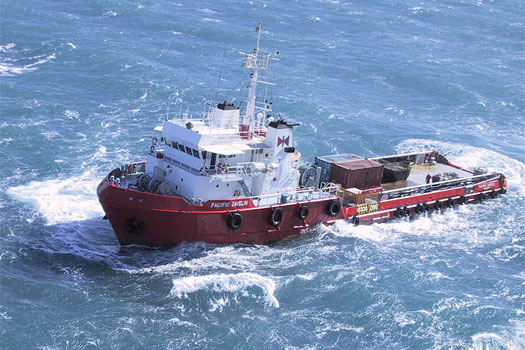 THE MOTHER SHIP 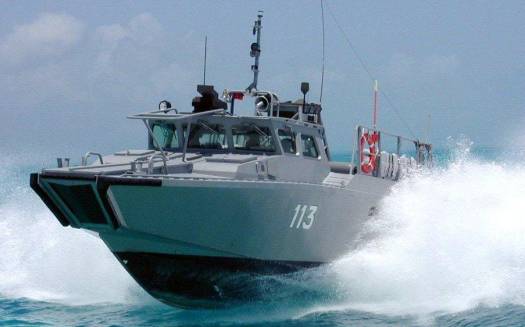 THE PATROL BOAT 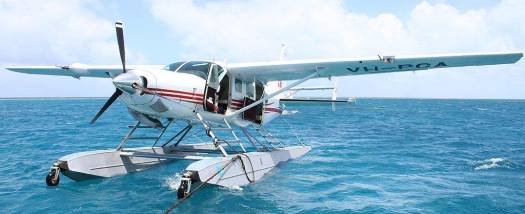 THE AMPHIBIAN |
||
 The Scientific Research Station and Monitoring Sites In progress... This is the key to understanding the Chagos!!! But
there's no Foundation yet which has offered to
fund this sort operation. Then again, the
MPA has only been in operation for a year!
So, to show some of the things that need to be
monitored, and to demonstrate the vast areas yet
to be explored, here's the blurb on "science" from
the Chagos Environmental Network's April 2011
"First Anniversary of the BIOT MPA" newsletter:
"A survey of
the Chagos islands was recently undertaken by
scientists from Royal Botanic Gardens Kew and by
ornithologists. They
are developing a systematic method of assisting
natural restoration from coconut monoculture to
native hardwood trees, and are prioritising
islands of the archipelago on which to enhance
conservation efforts. The
return of native vegetation is occurring
naturally, but extremely slowly. "Because of conservation measures and a very effective local conservation policy on Diego Garcia, the red-footed booby colony which prefers natural vegetation has already expanded to become the Indian Ocean’s largest colony. Also on Diego Garcia, studies on coconut crabs have shown that the Chagos has the densest population of this species in the world (up to 600 per hectare, many of them huge in size). This is a species which is widely exploited and therefore much rarer on other less-protected islands. [The photo here depicts the capture of a rat by a gravid female adult coconut crab. (photo: Charles and Anne Sheppard)] . 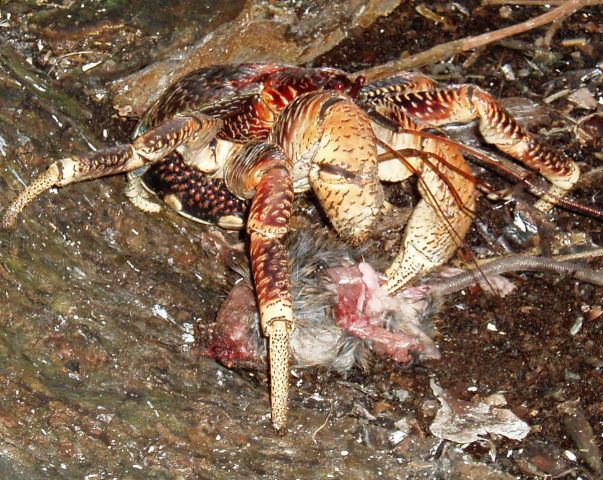
On May 15, 2011, the Chagos Conservation Trust issued the following on this subject: British
Indian Ocean Territory
Scientific Programme and Facility The following scientific programme was put forward to the Royal Society Global Environmental Research Committee in 2007/2008 by Professor Charles Sheppard (University of Warwick), Professor Alex Rogers (University of Oxford) and Dr Heather Koldewey (Zoological Society of London) following discussion with scientists engaged on related work and the Royal Society and with the support of the Chagos Conservation Trust. The Royal
Society commented (25 August 2008) 'The Royal
Society Global Environmental Research Committee
recently considered a proposal by Professor Charles
Sheppard from Warwick University for funding a
research programme in the Chagos Archipelago.
Although we were unable to fund this proposal due to
a change in our funding structures, the Committee
recognized the very high scientific and
environmental values of the Chagos, and supported
the urgent need for a comprehensive programme of
research.’ Overall
objective: To use the Chagos Archipelago as a
globally significant site for understanding
biodiversity and ecosystem function in the Indian
Ocean. The Chagos Archipelago (British Indian Ocean
Territory, BIOT) lies in the geographical centre of
the Indian Ocean. It is the ocean's most remote
group of atolls, and the only one which has been
uninhabited for over 35 years. It has (1) Global reference site for biodiversity and ecological analysis. This proposal will establish Chagos as a central reference site for tropical marine studies in the Indian Ocean. These will include studies of reef biodiversity and ecology, including deep-reef habitats and the upper bathyal zone of the atolls. Interest has been expressed by international programmes including Census of Marine Life's (CoML) Coral Reefs Programme (Creef), the US National Coral Reef Institute, and by numerous other institutes and universities. (2) Long-term, global climate change monitoring for atmospheric gases, sea levels, sea surface and deeper temperatures, using Chagos as a reference site. The unique undisturbed nature of the archipelago will also provide unrivalled opportunities to study the impacts of climate change on reefs from the molecular to community level. (3) Evolutionary and biogeographic status studies of Chagos in the Indian Ocean, particularly its putative role as an up-current source for the massive, overexploited 'sinks' of the western Indian Ocean. (4) Research facilitation through provision of a permanent facility in Diego Garcia atoll to help with scientific projects and storage of equipment. This will respond to the many requests from researchers and institutions for samples, measurements and readings from this location, in order to obtain 'baseline' information against which to compare data from around the world. (5) Public understanding of science to communicate the ground-breaking, diverse and interdisciplinary science on Indian Ocean coral reefs being carried out in a remote region (that is a UK Overseas Territory). The booklet 'The Chagos Archipelago: Its Nature and the Future' published by the Chagos Conservation Trust in 2009 included the following passage on the subject of a Permanent Scientific Facility: "So far scientific monitoring and research have been carried out with official support, including the essential role of the BIOT Patrol Vessel. The present mechanism of expedition-type research visits has served well enough in the past but there is now a need for a small permanent facility which remains for authorized scientific work. Much new science requires equipment which cannot simply be flown out on a temporary basis but needs a non-humid, fixed location." At the present time increasing the research programme and enforcement might have a higher claim on limited funding than a new facility. It is important that that location is logistically the most convenient, would cost the minimum amount to build and maintain and would do the minimum damage to the environment. All of these factors point to Diego Garcia being the best location.
|
||
|
What About Sport Fishing? Please
note that since 1998 the BIOT government has
regulated recreational fishing on and around Diego
Garcia, and placed most of the lagoon and outer
waters off limits to fishing. However,
unless the proposed MPA includes an exemption
for DG's territorial waters, it would ban
all recreational fishing by personnel stationed on
Diego Garcia. I believe that the research to
date shows such a ban is unnecessary for the
environmental health of the Chagos (see Chapter 7 of the BIOT's
Conservation Management Plan). If you want them to talk about recreational fishing, you should write letters to your Commanding Officers, the Secretary of your service, and the Secretary of State. Otherwise, they won't and you'll get to sit on the beach and wish you had something to do. |
||
 What About The People and Politics that Surround the Resettlement of the Chagos Islands? Right up front, I
tell you that I support the Diego
Garcian
Society
(DGS) and its desire to maintain a physical
relationship with the homeland of its members,
so the MPA needs to have a provision protecting
the rights of the Chagossians to visit and work
and subsistence fish it the B.I.O.T.,
whether or not they are given the right to
return to the Chagos (see
page
13 of the Consultation Document). I also
support the DGS's desire to allow individuals to
resettle on Diego Garcia, but only if the
B.I.O.T. remains British. (Keep reading -
hopefully the whys and wherefores will become
clear in this section). Almost everyone, even the judges who ruled on the various court cases and the government functionaries who have had to refuse to give the islanders anything for decades believe there is a moral imperative to resolve the "additional compensation" issue. It is the "Right of Return" that is problematic in the extreme. This demand has been included in essentially every islander claim since Michel Vincatassin filed the first legal action in 1975. The follow on questions have always been things like "To What?" and "Who Will Pay For It?" These basically refer to the fact that there is no surviving infrastructure from the Plantation era, and thus whatever the returnees would need would have to be "built from scratch". No
Chagossian has ever asked to return to what was
there during the Plantation era. There were
"no phones, no lights, no motorcars, it was
primitive as could be" to quote the Gilligan's
Island song. So, in 2000, the UK funded a
study to determine if resettlement was
feasible. The
preliminary study concluded that there was no
physical reason why the outer islands could not be
repopulated. The
final work in 2002 said resettlement was "not
feasible". There is now
some
controversy about the conclusions of the
study, but I have not found any evidence that
anyone doubts that resettlement would be
costly. Not only the building costs, but the
sustainment costs as well. How
much of those sustainment costs are offset by
local industry is the real question when it comes
to accommodating resettlement of the
islands. If the settlers were to be provided
with all their necessities of life, as is done on
the base at Diego Garcia, then settlers could live
"in harmony" with the MPA. If they need to
generate some of their own cash, then the
determination of what is sustainable is still to
be made. Eco-tourist hotels and commercial
fishing are the two ideas consistently touted for
funding the resettlement. This is to be
expected as there are no other known resources to
exploit in the Chagos, even thought the Government
of Mauritius has claimed the same area as the MPA
for oil and gas exploration and extraction. Further
discussion about the potential for resettlement
was delayed after 2002 by the continuing court
cases filed by Olivier Bancoult, until in March
2008, the UK Chagos Support Association
(UKCSA) proposed resettling Peros Banhos Atoll,
which is about 125 miles northwest of Diego
Garcia. They established a website
(www.letthemreturn.com - now defunct) and posted
the proposal which included an airfield, docks,
fuel storage facilities, power plants &
electrical distribution, agricultural fields (they
planned to grow their own food), administration
center, eco-tourism high-end hotel, commercial
fishing operations, and single-family homes
for 2,500 returnees. This is the "Returning
Home" plan, often called the Howell Plan
after its primary author. The main flaws in
this Plan were the failure to consider that the
entire land mass of Peros Banhos is 13 square
kilometers - 3,212 acres (scattered across 32
"micro-islands", the
largest of which is only 320 acres and
the distance from Mauritius is about 1,200
nautical miles (as with every other plan presented
by UKCSA and its adherents, transfer of the
islands to Mauritius is central).
Nevertheless, the Plan was pushed hard until it
was abandoned as unworkable, although in the Times
article linked above, Mr. Howell claimed
vindication of his Plan. In Parliament, there is a Chagos Islands All-Party Parliamentary Group (CI APPG) which is similar to a Congressional Caucus in the U.S. Jeremy Corbyn, is the Chair and as you can see if you read the entire debate on March 10th, the main proponent of sending the Chagossians back to the Chagos, to make up for taking them away all those decades ago. As of April 2011, the membership of the APPG consisted of: OFFICERS TWENTY QUALIFYING MEMBERS
(Parliament need only publish the names of 20
members, regardless of how many there may be. We do not know how many
more members there are, if any): Groups
designed to "help" the Chagossians seem to bloom
continuously. When the British government
announced the public comment period for the
proposed MPA back in November 2009, a new
organization emerged, the Marine Education Trust
(MET), urging the public to not
support the MPA until the "Chagossian Question"
has been resolved completely. This
common denominator is the chief spokesman opposing
the establishment of an MPA which does not include
commercial fishing and resettlement, is David
Snoxell. Mr. Snoxell is the "Co-ordinator"
of the CI APPG, Chair of the MET, and
was British High Commissioner to
Mauritius from 2000-2004, where (according
to a 2007 interview with Malcolm
McBain) he developed the idea and then lobbied his
own government to cede the Outer Islands of the
Chagos (everything but Diego Garcia - e.g., the
area of the MPA) to Mauritius immediately.
He now writes opinion pieces and gives interviews
urging international pressure (including in the
UN) against the UK to overturn the MPA's no
commercial fishing provisions, and to repopulate
the islands and turn them over to Mauritius (see his Mar. 31, 2010 interview).
On Feb 11, 2010, Mr. Snoxell sent a
letter to Minister Milliband stating that
"resettlement by Chagos islanders and a transfer
of sovereignty to Mauritius is the best way
ahead." The MET website's Chagos
Campaign
page on April 30, 2010, continued to
state: "Full no-take
protection was one of the FCO's preferred
options for the MPA, and all of the options
initially proposed excluded any kind of fisheries
or similar marine activities within the reef
areas. These options did not take account of
the wishes of the Chagossian community ...
[therefore] The Marine Education Trust
joined other individuals and organizations in
campaigning against full no-take
protection." This despite the fact that on
April 27, 2010, he emailed me that "I have
never, and do not support commercial fishing or
the aquarium trade!" to my by which I assumed he
meant, 'in the Chagos', although he did not
exactly say so. Mr. Snoxell is an expert at
the use of the English language, that's for
sure. He works tirelessly on virtually all
the current pro-Mauritius, Bancoult-support
actions in the UK. So. As of this writing, the CRG-supporting organizations all oppose the MPA unless it repopulates the islands with Chagossians who will make their livelihoods from the islands and the surrounding waters. Not only that, from the pamphlets and brochures and testimony in the various court cases, they all want to return Chagossians to the island as a group. Only
the DGS asks for a right of return to Diego Garcia
and believes return is an individual, not a group
decision. All the rest view the Chagossians
as a homogeneous mass that can be moved about at
will - manipulated as it were. And there is
always that element of racism that is found
universally in the communal philosophies that
drive many seekers of social justice. For
example, Richard Gifford, Bancoult's attorney in
the case before the European Court of Human Rights
recently called the islanders "the anthropomorphic
native species on Chagos".
Dictionary.com defines anthropomorphic as
"ascribing human form or attributes to a being or
thing not human."
Was this just a bad choice of adjectives, or does
it reveal that old, white Englishmen may still be
manipulating the islanders for their own
purposes? I also wonder what Al Sharpton
thinks of that description of the descendants of
African slaves? Here's What I Think About the "Chagossian Issue"... (as if my opinion mattered in the least) Is there a reasonable alternative to an archipelago that allows no one to enter but military personnel and scientists, or one teeming with hungry and poor masses of humanity catering to the Mauritian fishing and tourism industries? Of course there is (or I never would have brought it up)... 1. We have a moral
obligation to the Chagos Islanders to compensate
them fairly. Regardless of the
conclusions of the UK and US courts, we created
the conditions which left them prostrated before
an uncaring and manipulative Mauritian government
for 35 years. The UK
has done a lot to compensate the islanders,
including granting them full British Citizenship. But more is due,
including US assistance in balancing the books. 2. These British Citizens
of Chagossian descent want the same things we
all want - a decent
standard of living, a good education, opportunity,
freedom of choice. 3. Many Chagossians have
an emotional relationship with the archipelago. Many want to maintain a more physical
relationship - to live there, or work there,
and/or visit on occasion. Americans
in particular can understand this longing to see
the "old country". But,
just
like with the islanders, we tend to remember only
the good parts of our past, and we have no
interest in returning to malaria-infested African
swamps or the slums of Glasgow.
From what I have heard and read,
Chagossians have no interest in returning
permanently to a Chagos without electricity, a
hospital, or any other modern convenience. However, that does not
lessen the emotional bond with the homeland. 4. The value of the
Chagos as a functioning, virtually pristine
ecosystem is priceless to the world of science. Its primary
value is as a standard by which to measure all
other marine environments, and planetary health. 5. As such, the MPA must
be protected from extractive industry. So, no
commercial fishing, no sea-bed exploration and
mining, no collecting reef fishes or coral for
aquariums in rich homes and businesses should be
permitted. 6. Therefore, settlements
that would require extractive industry to
survive must be prohibited. Any
population centers must be strictly regulated to
prohibit pumping sewage into the lagoons or
constructing fuel storage depots leaking toxins
into the freshwater lenses, etc., etc., etc. 7. Combined, all these
factors mitigate against the resettlement of the
archipelago. In addition, the UK has valid concerns
regarding the costs and care for a permanent
population, and permanency does not appear to be a
valid option for the Chagossians currently. 8. However, allowing the
islanders to return as long-term, even life-long
employees on Diego Garcia is a valid compromise
to meet both the desires of the Chagossians, the
concerns for the environment, and the military
use of Diego Garcia.
Contractors doing business in the BIOT must
provide Chagossians with preferential hiring
selection when all other qualifications are equal.
A formal management training program should
be instituted to hone the skills of Chagossians
who show promise.
In addition, a local economy composed of
cottage industries and truck farming should be
encouraged among the employees and their families.
Over time, a “native corporate trust”
should be formed to integrate and manage the
various formal positions occupied or potentially
occupied by Chagossians. 9. There is little if any
difference between having British Citizens
living just outside the fence at RAF Lakenheath
and NSF Diego Garcia. There little or no
difference between allowing qualified and cleared
British Citizens to work on RAF Lakenheath and NSF
Diego Garcia, and it is important to remember that
the Chagossians living in the UK are British
Citizens. 10. The current
prohibition against marriage and dependents on
the base at Diego Garcia must be revised in
favor of long-term employment of Chagossians. This practice is
left over from those times when the development of
Diego Garcia was too primitive and limited for
dependents, and when the UN’s Committee of 24 was
an agency to be feared by Western Colonialists.
Currently,
permitting married couples and dependent children
to reside in the Chagos is left entirely to the
discretion of the Immigration Officer (see BIOT
Immigration Ordinance 2004, Paragraph 9). Of course none of us are
so naïve as to believe that policy is not set at a
much higher level, to be implemented by the
various Immigration Officers.
As no married couples are allowed on Diego
Garcia, the policy clearly is to deny married
persons or dependent children to reside there,
although they are routinely permitted on yachts
anchored in the northern atolls.
It should be noted that the lifting of the
marriage ban is not the same as granting a right
of abode or re-settling Diego Garcia. Instead, it permits long
term employment where the workers are not
separated from their families in the process. This practice is common at
places as diverse as the old Panama Canal Zone,
Ascension Island, and US National Park employee
housing areas. 11. Although Chagossians
employed for long terms on Diego Garcia would
not currently be considered permanent residents,
they will require additional family-oriented
infrastructure -
housing, schooling, commissaries, and recreational
facilities segregated from the unaccompanied
population.
13. There is nothing to be
gained by the Chagossians by aligning with the
government of Mauritius. The Mauritian government has kept the
Chagossians uneducated and underemployed for four
decades, and uses them as pawns in its continuing
sovereignty contest with the UK. 14. Currently, the needs
of any population of Chagossians in the islands
is best met by the British Government and the
constitutional monarchy it represents. 15. Therefore: The U.S. and U.K. should ensure that
British Citizens of Chagossian descent receive
preference in hiring for jobs on Diego Garcia, and
establish a management training program with the
aim of employing as many qualified Chagossians as
possible for the Base Operations and Support
functions on the island.
The employees of the
base at Diego Garcia should be provided with the
opportunity to bring family members with them to
the job, and compete for long-term, even
life-long, employment.
No repopulation of the fragile Outer
Islands should be considered.
Period. Only
Diego Garcia should be occupied.
In
the
event that repopulation is ever approved, the
BIOT must remain British in perpetuity. The UK must never again abandon
citizens to a foreign government. |
||
|
Here are some links to the environmental literature about Diego Garcia and the Chagos Archipelago which will help you understand the 'big picture'...
Here's a special pitch for the helping the environment of our favorite island. These are the key non-governmental organizations (NGOs) behind the creation of the MPA.
|
||
|
|
||
